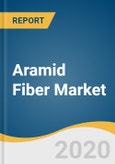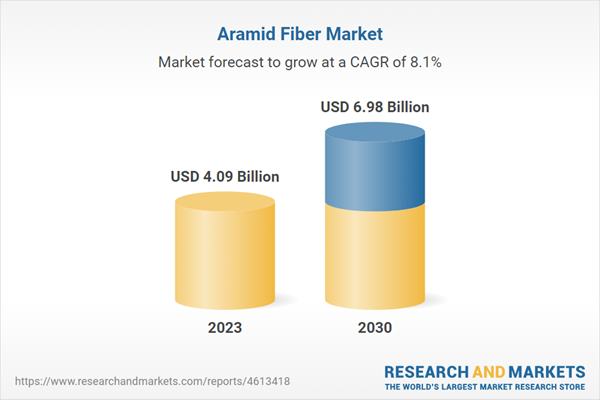Aramid Fiber Market Growth & Trends
The global aramid fiber market size is expected to reach USD 6.98 billion by 2030, registering a CAGR of 8.1% from 2024 to 2030. Superior properties, such as strength and heat-resistance, of aramid fiber have promoted its utilization in the production of body armor fabric. The growing need for security and protection across various industries, such as mining, healthcare/medical, oil & gas, building & construction, and military, is projected to propel the market growth. In addition, stringent regulations in developing economies related to occupational safety are likely to benefit the market growth over the forecast period.Aramid fibers are being increasingly used as an alternative to metal wire and organic fiber in structural composite applications in the aerospace and marine sectors, and ropes for oil rigs in offshore locations. In addition, product benefits, such as non-aggressive wear & tear on drums and discs and fade resistance, are anticipated to propel its usage. The manufacturing process involves the use of a number of high-cost chemicals, which elevates its production cost. In addition, huge capital investment in machinery and production process is anticipated to pose a threat to the growth of the market. However, the development of cost-beneficial production facilities is anticipated to boost the market growth.
Aramid Fiber Market Report Highlights
- Para-aramid product segment led the market and accounted for about 75.0% share of the revenue in 2023 owing to its properties, such as an excellent strength-to-weight ratio coupled with superior chemical resistance
- Security & protection segment led the market and accounted for more than 37.3% share in 2023 owing to concerns regarding the protection of personnel in the military and industrial sectors
- Europe led the market and accounted for over 34.6% share of global revenue in 2023. It is expected to witness growth owing to rising employment of security & protection measures across several industries.
- The market is highly competitive owing to the presence of several players that are primarily consolidated in the Asia Pacific and North America, whereas Europe exhibits a limited presence of the established players
Why should you buy this report?
- Comprehensive Market Analysis: Gain detailed insights into the global market across major regions and segments.
- Competitive Landscape: Explore the market presence of key players worldwide.
- Future Trends: Discover the pivotal trends and drivers shaping the future of the global market.
- Actionable Recommendations: Utilize insights to uncover new revenue streams and guide strategic business decisions.
This report addresses:
- Market intelligence to enable effective decision-making
- Market estimates and forecasts from 2018 to 2030
- Growth opportunities and trend analyses
- Segment and regional revenue forecasts for market assessment
- Competition strategy and market share analysis
- Product innovation listing for you to stay ahead of the curve
- COVID-19's impact and how to sustain in these fast-evolving markets
This product will be delivered within 1-3 business days.
Table of Contents
Companies Mentioned
- Teijin Ltd.
- Yantai Tayho Advanced Materials Co.
- E. I. du Pont de Nemours and Company (DowDuPont)
- Hyosung Corp.
- Toray Chemicals South Korea, Inc.,
- Kermel S.A.
- Kolon Industries, Inc.
- Huvis Corp.
- China National Bluestar (Group) Co., Ltd.
- SRO Aramid (Jiangzu) Co., Ltd.
Table Information
| Report Attribute | Details |
|---|---|
| No. of Pages | 198 |
| Published | November 2023 |
| Forecast Period | 2023 - 2030 |
| Estimated Market Value ( USD | $ 4.09 Billion |
| Forecasted Market Value ( USD | $ 6.98 Billion |
| Compound Annual Growth Rate | 8.1% |
| Regions Covered | Global |
| No. of Companies Mentioned | 10 |









